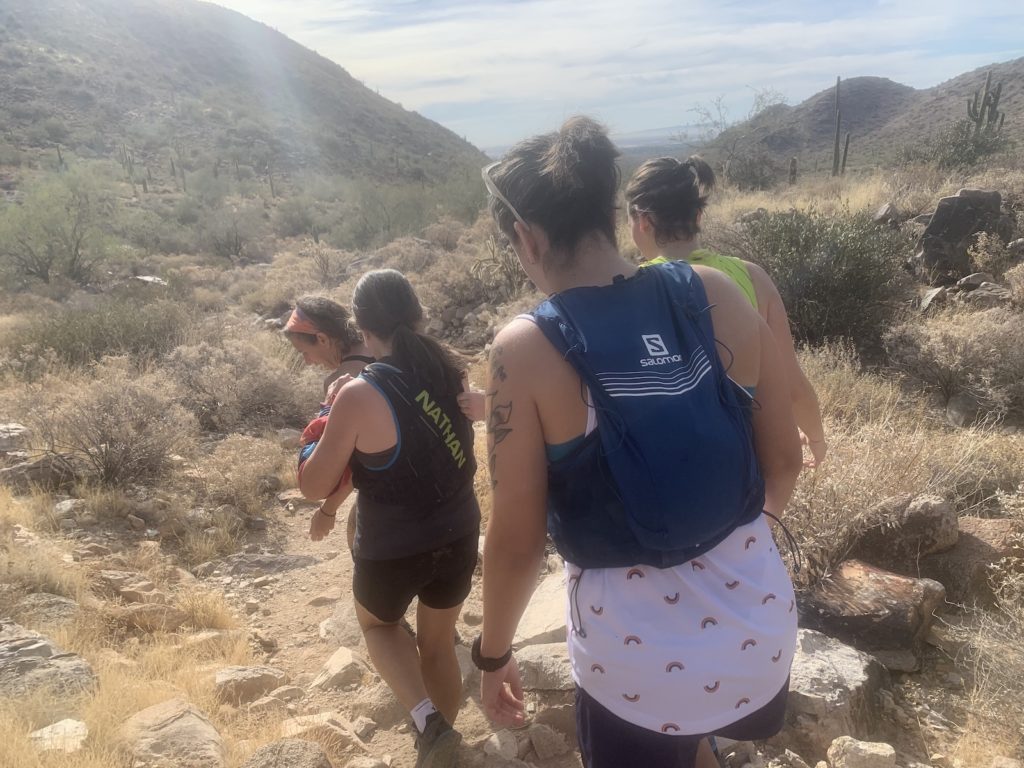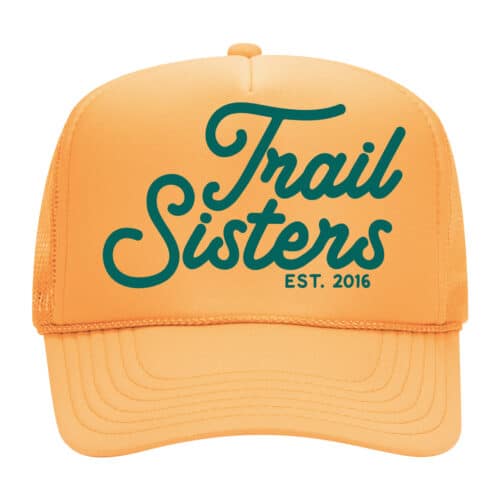Lauren and I had just turned around and started back down the trail when her phone rang.
“It’s Analis, this can’t be good.”
Her wife Analis had been behind us on the trail with my co-leader Chris, the other runner in the group sandwiched between us. We had stopped periodically to check in and had just seen the fifth runner moments ago.
“Chris says put Des on the phone.”
I took the phone; I could hear the tension in her voice.
“You need to come down right now. She fell, I think her wrist is broken.”
I told her to try to contact the park ranger and I would be there soon.
Running down the mountain my mind replayed points from my Wilderness First Aid (WFA) class in my head. Within a few minutes we reached the other runners. I slowly approached, taking in the scene. There was also another bystander to the side on the phone, I figured he was talking with the park rangers. I made sure the injured runner was coherent and her pulse was normal. I checked her for other injuries and reassured her while I did. It was clear that the wrist was broken. We brainstormed for what items we had to make a splint. We were just about to send someone to the cars for items when we realized one of us had a frozen bottle that was perfectly sized. Using that as support, my vest as padding and a buff and a tank as ties we got her splinted.
By this point the bystander had disappeared, leaving without giving any kind of information from the phone call. Since we had moved her injured arm to splint it, I rechecked the runner’s vitals. Then I calmly explained that we could sit here and wait, or if she felt up to it, we could just head to the trailhead. She agreed to try to stand and then see from there. Once we had her on her feet and she didn’t feel dizzy we started the hike out.

The injured runner was in good spirits considering and we kept her occupied with stories and jokes. Suddenly a search and rescue helicopter appeared. Apparently, our friendly male bystander hadn’t had the same faith in us that we had, even though we had told him repeatedly there was someone certified in Wilderness First Aid as well as two vet techs in our group. We called dispatch to alert them that we had moved the injured party and the helicopter located us and landed.
As the helicopter team came over, they pointed out that the injury didn’t look that bad (we knew) and asked who had splinted the arm (me). Since the helicopter was already there our friend decided to take the quicker way to the trailhead. A ground crew had also showed up by foot and the pilot looked at the remaining four of us and said, “You’re in good hands to get back to the trailhead ladies.” To which we replied “Yeah, I think we got it.” We ran back to the cars, a fire truck brought us the injured runner’s keys so we could driver her car to the ER for her. After a quick hug and some reassurance our job was done.
Reflecting on the events through the lens of my WFA training I feel like there are some learnings that would be helpful for anyone on the trail.
- If you have the means, take courses to prepare you for situations you may encounter out on the trail. I took my WFA through NOLS and REI, and when it expires, I’m going to level up to the Wilderness First Responder (WFR, often referred to as “woofer”) to make sure I’m maximally prepared. Even though in the moment I didn’t follow the steps I had been given verbatim, the knowledge I had gave me confidence that I could handle the situation.
- Stay calm. My kids are probably sick and tired of hearing me say “The worst thing you can do in any situation is panic or react.” Staying calm helps you think clearly and helps those around you stay calm as well. I am reminded of another trail mishap where I fell on a downhill and caught myself fully on my face. The hikers near me were freaking out and yelling to call 911. I was able to calm them down, sit down to assess the situation and hike to a road, get a ride to my car and drive myself to care. My ear was fully split, and I ended up with 21 stitches but there was nothing seriously wrong with me.
- Assess situation. There may be something you think is the primary injury, make sure to fully assess the person in case there’s not another injury that’s more severe that you are missing. There are a lot of situations that you can handle on your own or within your group. There are times when you should contact 911 immediately. These include things like potentially fatal bleeding, changes in consciousness, stroke, cardiac arrest, someone who is not breathing, spinal injuries etc. If there isn’t an immediate risk to life it makes sense to take the time to assess the situation before calling 911. When I think of our situation, any helicopter flight and landing present some level of risk to the crew, in extreme situations it can also present a risk to those hiking in to help. It also takes up emergency resources that could potentially be needed elsewhere. I suppose it also helps to make sure that those around you aren’t calling 911 unnecessarily.
- Reassure the injured party. They’re probably in pain. They maybe be worrying about how they’ll get out. They might even be upset at themselves for getting hurt. Reassure them that everything is under control and you’re going to help. There may be people nearby who are not handling the situation calmly, get them away from the injured person, especially if they are risking become a victim themselves (e.g., passing out from sight of blood, getting themselves so worked up they hyperventilate, go into shock, etc.)
- Hike out if you can. Of course, if it is an emergency call 911, but if you can hike the person out do that. This gets the injured party closer to medical care quicker. It can also help give the injured party a feeling of agency as they are participating in their own rescue.
- Take care of the injured party and yourself. Depending on the conditions and the length of time you’ll be out in them make sure you’re taking care of everyone. In the heat this might mean taking breaks in shade and drinking fluids. In the cold it may mean keeping everyone warm. If it’s going to be a while, make sure there’s also food and water to last. Keep the injured person, and everyone in your group, calm, comfortable and safe.
- Use what you have. In hospitals there are lots of great supplies made specifically for handling different patient situations. In the wilderness there are lots of great tools if you use a little ingenuity. Use what you have and use the thinking power of whoever you have with you, and you may be surprised what you can come up with.
- Travel with Bad Ass Bitches (aka BABs). Waiting at the trailhead for the car keys to be delivered the four of us agreed that there wasn’t another group we’d rather be with to handle the situation. One of my favorite parts of trail running is that it’s introduced me to so many badass women. I have a network of them that I know I can count on in a variety of situations, on the trail and in life. Find those women in your life and hold on to them.

Overall, aside from missing a chunk of my long run, the day ended well. I hope that I’ll never have another situation like that or worse out on the trail, but I enjoy being confident in the knowledge that if I do, I’m equipped to be useful to myself and those around me. I see it as part of being a good trail user, as vital as being polite to other trail users and protecting the wild spaces I explore.














